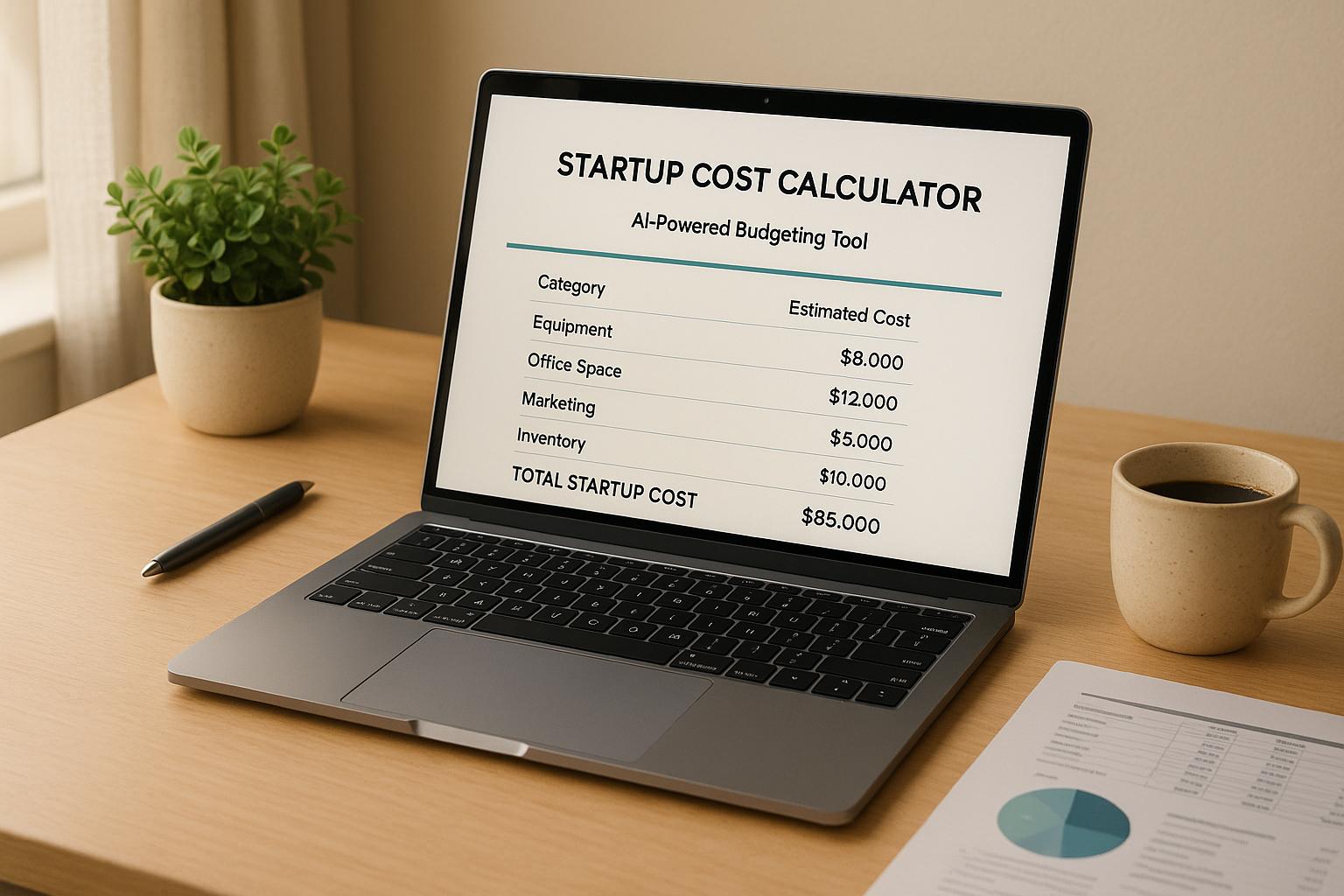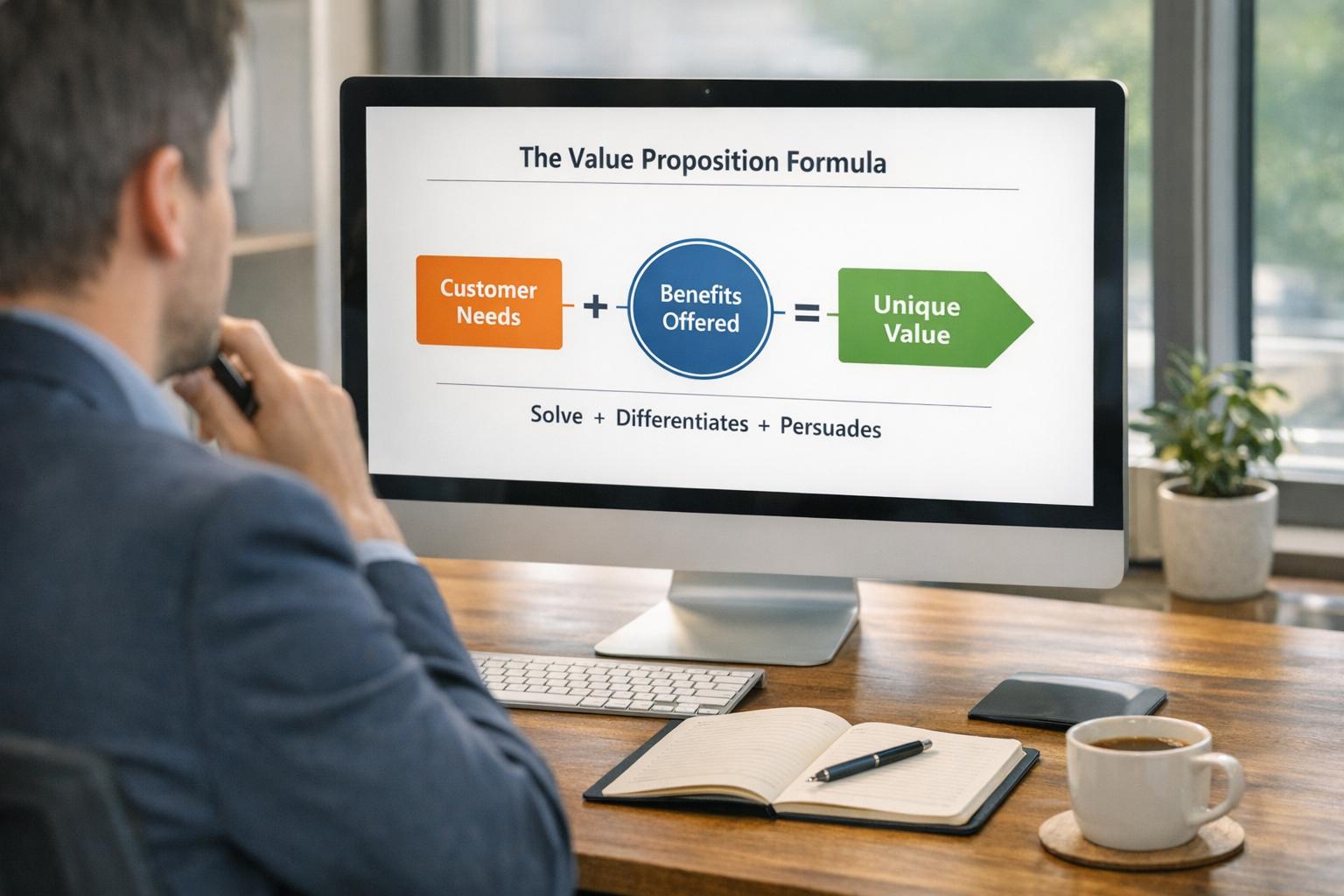
When I started budgeting for my business, I thought I had it all figured out. But I missed critical costs, underestimated expenses, and left no room for unexpected challenges. This nearly cost me $15,000 and could have derailed my startup.
The solution? AI-powered budgeting tools like IdeaFloat's Startup Cost Analyzer. This tool helped me identify hidden costs, adjust my budget, and secure the funding I actually needed. It flagged overlooked expenses like insurance, legal fees, and contingency funds, giving me a clear, accurate financial plan.
Here’s what I learned:
- Manual budgeting is risky: It often misses hidden costs and relies on guesswork.
- AI tools save time and money: They analyze real-world data to provide precise, tailored budgets.
- A solid budget is essential: It’s the foundation for your business’s success and credibility with investors.
If I hadn’t used this tool, I would’ve run out of money in just three months. Instead, I launched with confidence and avoided the fate of startups that fail due to poor financial planning.
How to calculate business startup costs
The Problem: Why Manual Startup Cost Estimation Falls Short
Relying on manual methods for startup budgeting can leave entrepreneurs vulnerable to costly mistakes. I learned this the hard way when my dependence on spreadsheets and rough estimates nearly led my business to disaster.
The numbers paint a grim picture: over 20% of small businesses fail within their first year, often due to insufficient funding. I came dangerously close to joining that statistic by falling into common budgeting traps. These issues often stem from basic estimation errors that snowball into larger financial troubles.
Relying on Rough Guesswork
Many entrepreneurs, myself included, approach budgeting with an overly optimistic mindset. We base our financial plans on industry averages or gut instincts rather than hard data. When I first mapped out my startup costs, I underestimated nearly everything. I assumed minimal marketing expenses, smooth product development, and that I wouldn’t need much in the way of cash reserves.
One of my biggest missteps? Overestimating how quickly my business would become profitable. I confidently predicted breaking even within six months, which led me to set aside only a small financial cushion. This kind of wishful thinking can quickly spiral out of control: underestimating one expense often leads to a chain reaction of financial shortfalls, eventually threatening the entire operation.
Missing Hidden Costs
Another common pitfall is focusing only on obvious expenses - like development and legal fees - while ignoring smaller, less apparent costs. I made this mistake and quickly saw how these "hidden" expenses could drain my capital.
For example, I underestimated the impact of recurring costs like software subscriptions, insurance premiums, and unforeseen marketing expenses. Worse, I splurged on high-end software and equipment that, in hindsight, weren’t critical for my launch. This misallocation of funds left little room for the unexpected.
Marketing was another blind spot. I naively allocated just $2,000 for my first year, assuming word-of-mouth would be enough to drive growth. It wasn’t. Without a solid marketing strategy, I struggled to attract customers and generate revenue. On top of that, I didn’t factor in contingency funds for emergencies, which meant even minor setbacks - like a delayed vendor payment or an unexpected fee - threw my budget into chaos. I also failed to account for the true cost of financing. Interest rates and fees on my business credit line added up quickly, further straining my cash flow.
These overlooked expenses didn’t just tighten my budget - they created a domino effect of financial stress.
What Happens When Budgets Go Wrong
Budgeting mistakes can lead to a cascade of problems that threaten both your business’s momentum and its credibility.
"Starting a business without enough capital is like setting out on a voyage without enough fuel. You may not realize you're doomed until you're stranded."
- Financial Advisor
When my budget started unraveling, I faced impossible decisions: should I delay my launch to secure more funding, cut essential features to stay on budget, or push forward and risk running out of cash mid-operation? None of these options were appealing, and each carried its own risks. To make matters worse, poor record-keeping led to legal and tax complications. Without accurate cost estimates from the beginning, running a startup felt less like building a business and more like gambling with its future.
The Solution: How IdeaFloat's Startup Cost Analyzer Works

When I was on the verge of exhausting my budget using manual estimation methods, I came across IdeaFloat's Startup Cost Analyzer. This AI-powered tool completely changed how I approached financial planning for my startup. It offered a practical solution to the challenges that had nearly derailed my plans. Instead of relying on guesswork or overlooking hidden expenses, the tool provided clear, data-driven insights to help avoid financial surprises. Here’s a closer look at what makes it so effective.
Main Features of the Startup Cost Analyzer
The Startup Cost Analyzer uses AI to evaluate your business details and deliver precise cost breakdowns tailored to U.S. market conditions. It factors in key elements like your industry, location, and business model, ensuring the estimates are grounded in reality. Expenses are categorized into fixed costs (like rent and equipment) and variable costs (such as marketing, inventory, and taxes).
One standout feature is its ability to uncover hidden costs that manual budgeting often misses, giving you a more complete financial picture. Additionally, the tool includes scenario planning, allowing you to tweak assumptions - like sales revenue or growth rates - and instantly see how these changes affect your budget.
Step-by-Step Process
The Startup Cost Analyzer guides you through building a complete financial plan. Here’s how it works:
- Input Your Business Details: Enter basic information such as your industry, location, projected launch date, and key business model specifics.
- Receive a Categorized Expense List: The tool generates a detailed list of expenses, which you can customize by adding or removing items to reflect your business needs.
- Adjust Costs in Real Time: Use interactive sliders to modify costs - like marketing budgets or office space needs - and immediately see the impact on your total budget.
- Generate Reports: Review a comprehensive cost breakdown and create reports formatted for investors and lenders, including summary overviews and detailed expense lists.
Built for U.S. Entrepreneurs
The tool is specifically designed with U.S. entrepreneurs in mind. It formats financial data in standard U.S. currency (e.g., $XX,XXX.00), making it easier to communicate with American investors and lenders. It also incorporates location-specific cost data, recognizing that expenses like rent, utilities, and labor vary significantly across the country. For example, when I selected Austin, Texas, the tool adjusted its estimates to reflect local commercial real estate rates, average salaries, and other regional costs.
On top of that, it accounts for relevant regulatory requirements, such as state registration fees and industry-specific licenses, ensuring your financial plan is as accurate as possible. Expenses are sorted into one-time and monthly categories, aligning with the reporting style that U.S. investors and lenders expect. This level of detail helped me approach funding discussions with confidence and professionalism.
sbb-itb-08dd11e
Case Study: How I Avoided a $15K Budget Overrun
When I first started planning the launch of my Austin-based e-commerce business, I estimated the total cost to be $28,000. I felt pretty good about my calculations and was ready to move forward. But then I used IdeaFloat's Startup Cost Analyzer, and what I discovered completely changed my approach. This tool revealed hidden expenses I hadn’t accounted for and ultimately saved me from a $15,000 budget overrun that could have derailed my business before it even got off the ground. Here's how it all unfolded.
My Original Budget Problems
My initial estimate of $28,000 included what I thought were all the essentials: inventory, website development, marketing, legal fees, equipment, and operating expenses. However, I missed several critical costs. Things like professional liability insurance, sales tax registration, merchant processing fees, and professional photography didn’t make it into my budget. On top of that, I didn’t set aside a contingency fund, leaving no wiggle room for unexpected expenses. While my numbers looked solid on the surface, these omissions left my plan vulnerable to financial surprises.
How the Tool Fixed My Budget
The gaps in my budget became glaringly obvious after I ran my numbers through IdeaFloat's Startup Cost Analyzer. The tool recalculated my expenses based on more comprehensive data and flagged several overlooked costs. For example:
- It identified a need for $1,800 in professional liability insurance.
- It recommended increasing my marketing budget by $1,800 to cover necessary tools and subscriptions.
- It added $2,400 for registration and legal fees that I hadn’t considered.
- Equipment upgrades required an extra $1,200.
- My initial inventory investment needed to jump from $8,000 to $10,000.
- Most importantly, the tool advised setting up a $5,800 contingency reserve for unexpected costs.
These adjustments completely reshaped my financial plan, giving me a far clearer picture of what I needed to launch successfully.
Manual vs. AI Budget Comparison
The difference between my manual calculations and the AI-powered analysis was staggering. Here's a side-by-side breakdown of the numbers:
Comparative Breakdown of My Initial Estimates and AI-Enhanced Projections
| Expense Category | Manual Estimate | AI-Powered Estimate | Difference |
|---|---|---|---|
| Inventory | $8,000 | $10,000 | +$2,000 |
| Website Development | $3,500 | $3,500 | $0 |
| Marketing & Advertising | $2,000 | $3,800 | +$1,800 |
| Business Registration & Legal | $1,200 | $3,600 | +$2,400 |
| Equipment & Software | $5,000 | $6,200 | +$1,200 |
| Operating Expenses (6 months) | $8,300 | $8,300 | $0 |
| Insurance | $0 | $1,800 | +$1,800 |
| Contingency Fund | $0 | $5,800 | +$5,800 |
| Total | $28,000 | $43,000 | +$15,000 |
The AI-powered estimate came out $15,000 higher than my original budget. If I had stuck to my $28,000 plan, I would have run out of money within three months. Instead, the Analyzer helped me secure additional funding upfront, ensuring I could cover all necessary costs and maintain healthy cash flow. This proactive planning allowed me to avoid the fate of the 38% of startups that fail because they run out of money. Thanks to this tool, I launched with confidence and had the financial stability to navigate my first year successfully.
Practical Tips for Entrepreneurs
After diving into the cost adjustments outlined earlier, it’s clear that accuracy in your input data is critical. To make the most of an AI cost calculator, focus on providing detailed, specific information rather than broad estimates. Here’s how you can refine your budget analysis and get more precise results.
How to Input Data for Best Results
The key to an effective startup cost analysis lies in offering more than just surface-level details. AI models work by analyzing thousands of past projects with similar technologies, features, and delivery methods to calculate costs. This means the more specific you are, the more tailored your results will be.
For instance, instead of simply stating "user login system", elaborate on the technical details. Mention required integrations, performance expectations, and scalability needs. The AI evaluates everything from database structures and API integrations to login systems and compliance requirements.
If your business falls under a specific industry, like Fintech, select that category to unlock relevant suggestions. For example, the AI might recommend secure onboarding processes, tax engines, wallet integrations, admin dashboards, and other optimizations. Be sure to include compliance needs like GDPR, PCI-DSS, or multi-language support if applicable.
Lastly, provide a clear picture of your target audience. Details about user demographics, behaviors, and preferences help the AI fine-tune cost estimates, turning raw data into a strategic financial roadmap. The more precise your input, the more actionable your output.
Conclusion: Better Budgeting Leads to Stronger Startups
The difference between a thriving startup and one that struggles often boils down to financial discipline. As we've seen, budgeting isn’t just about avoiding overspending - it’s about laying the groundwork for steady growth and smarter decision-making. When approached with care, financial planning becomes a powerful tool for driving success.
AI-powered tools take the guesswork out of budgeting, offering precision that can save money while enabling bold, data-backed decisions. This level of confidence boosts your credibility with investors, helps clarify expansion strategies, and equips you to tackle challenges without losing control.
Beyond immediate cost savings, these tools simplify financial management, make expense allocation clearer, and support sound decision-making. They offer much-needed visibility into your finances, allowing you to plan ahead and address potential hurdles before they become major issues. Most importantly, they help establish trust in your startup’s operations - a lack of financial clarity can lead to missed opportunities, shaken investor confidence, and even jeopardize the future of your business.
To fully reap these benefits, adopt a proactive approach to budgeting. Entrepreneurs who thrive in today’s competitive market know that strong financial planning creates a stable framework, allowing every part of the business to work with confidence. A secure financial foundation means your team can focus on growth instead of constantly putting out fires.
Make it a habit to revisit and refine your budgets regularly, base revenue projections on solid data, and always keep a contingency fund in place. Even the most advanced AI tools can’t predict every twist and turn in the unpredictable world of startups.
Think of your budget as more than just numbers - it’s your roadmap to success, a symbol of your reliability to stakeholders, and the safety net that ensures you’re ready to seize opportunities when they arise. These budgeting practices have been key to my startup’s success, and they can do the same for yours. Use them wisely.
FAQs
How does the IdeaFloat Startup Cost Analyzer uncover hidden expenses that are often missed during budgeting?
The IdeaFloat Startup Cost Analyzer leverages advanced AI to uncover expenses that might slip through the cracks with traditional budgeting methods. It evaluates your spending habits, flags unexpected or misaligned costs, and ensures no potential expense goes unnoticed.
With a clear and detailed breakdown of startup costs, this tool helps entrepreneurs sidestep financial surprises and maintain control over their budgets, streamlining the planning process and saving both time and money.
How can I ensure accurate data entry in the AI-powered startup cost calculator for better budgeting results?
To get precise results from an AI startup cost calculator, begin by compiling a list of all possible expenses. This might include items like equipment, permits, employee salaries, and marketing efforts. Make sure to use trustworthy sources to estimate these costs, and always present the amounts in USD, properly formatted with decimal points and thousand separators.
It's worth double-checking your numbers to ensure they align with current market rates. You might also consider running a small test project to confirm your estimates. Use any real-world data you collect to refine your inputs. By following these steps, you'll improve the accuracy of your data entry and receive more tailored budgeting insights for your startup.
Why is a contingency fund essential for startups, and how does the Startup Cost Analyzer help create one?
Having a contingency fund is crucial for startups. Think of it as your financial safety net - ready to catch you when unexpected expenses or revenue shortfalls pop up. It helps prevent cash flow issues and keeps your business moving forward, even when surprises arise. Without this buffer, even small hiccups could throw your financial plans off course.
That's where the Startup Cost Analyzer comes in handy. This tool provides accurate estimates of both your startup and operational costs, making it easier to set aside part of your budget specifically for unforeseen expenses. By planning ahead like this, you're giving your business a better shot at staying steady and thriving over the long haul.
Related posts
Get the newest tips and tricks of starting your business!


